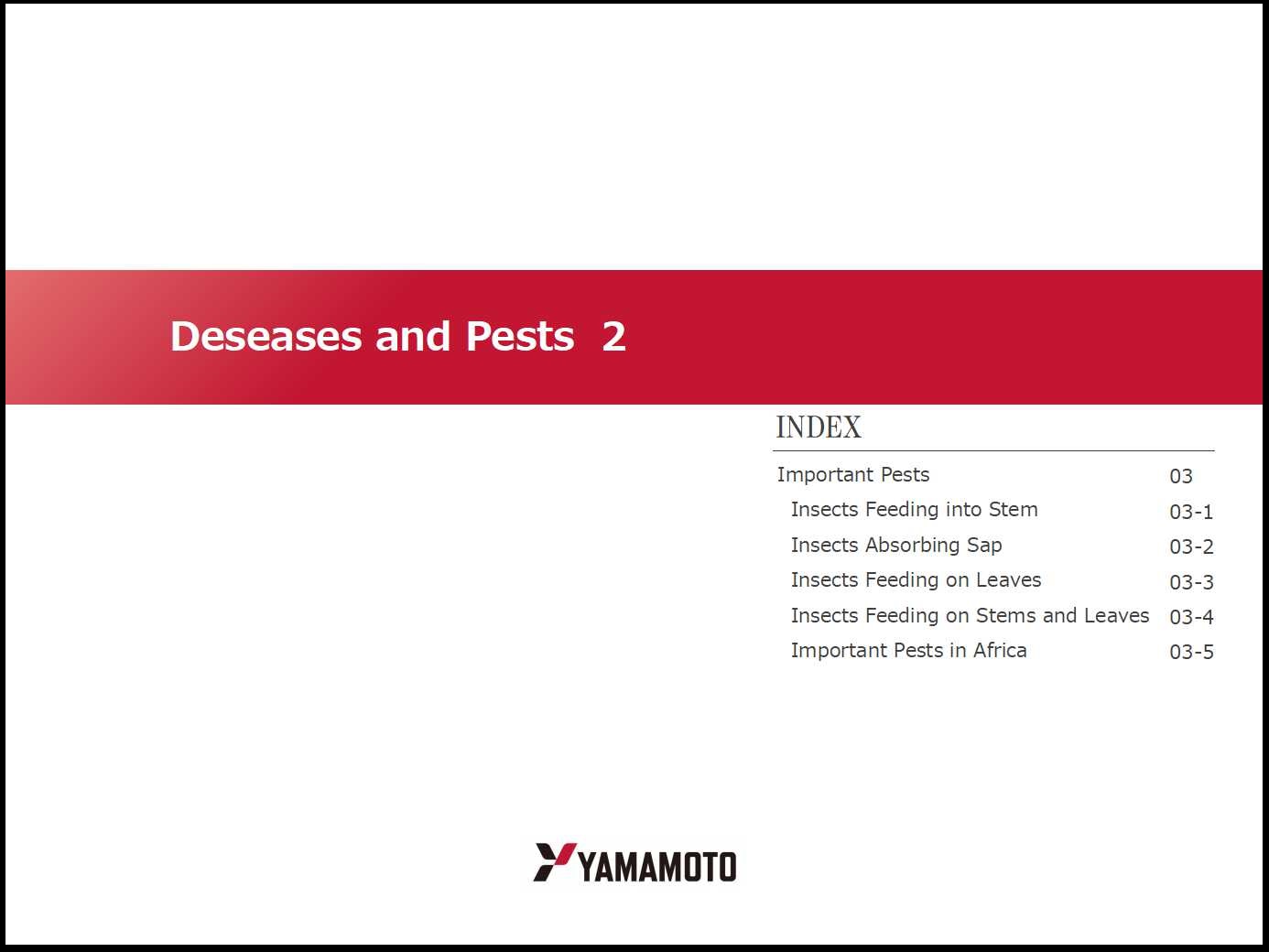16. Diseases and Pests 2
- INDEX -
Important Pests
Insects Feeding into Stem
Insects Absorbing Sap
Insects Feeding on Leaves
Insects Feeding on Stems and Leaves
Important Pests in Africa
Important Pests
Examining the important rice pests seen in tropical Asia by means of the part of rice plant they damage, the mode of damage is as described below.
Insects Feeding into Stem
Rice yellow stem borer (Scirpophaga incertulas Walker):
The larva feeds into a rice plant, discoloring its leaf sheath to brown. Some will become dead heart stems to develop white heads. In the rice nursery, the young rice plant will be damaged by the larva. Similar damage will be caused by the rice striped stem borer, the tropical leaf roller, and the white leaf roller.
Pink stem borer (Sesamia inferens Walker):
The larva will feed into a rice plant, causing serious damage of discolored stem, dead heart, non-extracting panicles, die-back of hills, and the like.
Insects Absorbing Sap
They absorb sap from the leaf sheath, leaf blade, panicle and grain.
They also include important virus disease vector insects.
Brown plant hopper (Nilaparvata lugens Stal):
In a tropical zone, both the adult and larva will cause damage throughout the growth process of rice. Rice often dies or falls down. Yield will decrease considerably, and if damaged after heading, the majority will become sterile.
This insect is a carrier of virus diseases.
White-backed plant hopper (Sogatella furcifera):
Plant tissues around its egg mass will turn yellow day by day, and the leaf blade may die. If too many live during the tillering period, rice will most likely die. The unique symptoms include discoloration of rice to yellow, dwarfing, retardation of growth, delay of heading, etc. IR45 and IR52 have some degree of resistance against it.
Green rice leafhopper (Nephotettix virescens Distant):
Their sap absorption itself will not wither rice. They carry various virus diseases that stunt rice plant. If damaged seriously in the early stage of growth, it will result in a considerable decrease of yield.
Rice white leafhopper (Cafana spectra Distant):
If damaged, the tip of the leaf dries out and yellow discoloration is initiated, which runs downward and , at the end, curls up the leaf.
Rice slender bug (Leptocorisa oratorius Fabricius):
The hatched larva and adult both damage panicle in the milky ripening stage. They leave traces of sucking on the surface of the paddy. Damaged grains will produce sterile or spotted rice. Their outbreak can destroy the entire harvest. Certain varieties with awn show considerable resistance to this insect.
Malayan rice black bug (Scotiniphara coarctata Fabricius):
Both adult and larva absorb sap from the leaf sheath, discoloring the rice plant to yellow, stunting it, and causing retardation of growth. Too many of them will wither the rice plant. Rice panicle is also damaged.
Rice mealy bug (Name of species unknown):
Damaged rice plant will be stunted and discolored to pale yellow. It accompanies a sooty disease. It also leaves a waxy substance of whitish color. Less tillering and dead hills can be seen.
Rice thrips (Stenohaetothrips biformis Bagnall):
Mainly a pest of the rice nursery. They leave whitish spots of splashed pattern on the area of the leaf, where they feed. The entire rice nursery may look yellowish, and leaves will curl inside along the vertical line, form a tube, and wither.
